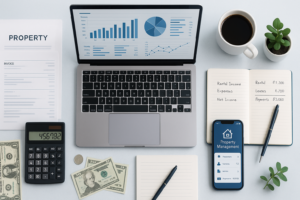
Understanding Key Performance Indicators in Property Management: A Comprehensive Guide
Success isn’t about comparing yourself to others but comparing what you achieve to what you can achieve. As a property manager, it’s important to have clear answers to some essential questions. How do you know if your company is doing well? How do you measure the success of your business? And how do you ensure you’re on the right track and staying focused on your goals?
These are the key questions you need to address. Key Performance Indicators (KPIs) are like golden formulas that can provide a clear perspective on where your business is heading and help you effectively manage its performance towards its objectives. So, it’s crucial to understand which property management KPIs are the most effective. Let’s understand more of this in this blog.
What Are Key Performance Indicators (KPIs)?
KPIs, or key performance indicators, are the fundamental yardsticks that show how well a business is doing. They’re not just numbers on a report; they help boost your business’s efficiency by clarifying your goals and focus points to everyone in the company. Plus, they help eliminate any confusion or misalignment that might crop up along the way. So, you can see why KPIs are pretty handy.
Why KPIs Matter in Property Management
Property management is like a beautifully choreographed dance where owners, tenants, and maintenance teams harmonize harmoniously. Each step is carefully planned to keep the property running smoothly. But how can you make sure everything is perfectly synchronized?
That’s where Key Performance Indicators (KPIs) come in. These valuable metrics not only measure the health and success of your property management efforts but also give you a deeper understanding of what’s going on. This helps you make informed decisions and continuously improve. With KPIs, you can confidently navigate the ever-changing world of property management and unlock its true potential.
Tenant Retention: The Heartbeat of Property Management
Tenant retention is not just essential but the lifeblood of property management. High turnover rates can be incredibly costly, not only resulting in lost revenue but also requiring significant resources to fill vacancies. That is why monitoring key performance indicators (KPIs) related to tenant satisfaction, such as lease renewal rates and tenant feedback scores, is crucial.
By tracking the percentage of lease renewals over a year, property managers can gain valuable insights into the overall satisfaction level of tenants and make informed decisions to improve retention strategies. Ultimately, prioritizing tenant satisfaction and focusing on long-term relationships can lead to a thriving property management business.
Financial Health Metrics: Keeping the Cash Flowing
In the property management world, where financial success is paramount, it is crucial to closely monitor and analyze key financial performance indicators (KPIs) to assess your managed properties’ profitability and overall financial well-being. One such imperative metric is the Net Operating Income (NOI), a reliable measure of a property’s economic viability. NOI is calculated by deducting operating expenses from the property’s total revenue.
A consistent positive NOI is not only an indicator of a healthy property but also signifies its profitability and long-term sustainability in the market. By diligently tracking and optimizing financial KPIs like NOI, property managers can make informed decisions to maximize returns and ensure the success of their property portfolios.
Maintenance Efficiency: The Silent Hero
Efficient maintenance is like the unsung hero of property management. It’s not just about keeping tenants happy but also about nipping minor issues in the bud before they become big headaches. KPIs, like how quickly maintenance requests are addressed and the percentage of repairs done on time, can give you a good idea of how efficient your maintenance team is. For instance, if they’re consistently quick to respond, it shows they’re on top of things and ready to take action.
Occupancy Rates: Filling the Gaps
Empty units equate to lost revenue, making tracking and optimizing occupancy rates crucial. One critical occupancy KPI to consider is the vacancy rate, which represents the percentage of vacant units in a property. A lower vacancy rate indicates better property performance, as it generates more revenue and suggests a more attractive property to potential tenants.
For example, imagine a property with a vacancy rate of 5% compared to one with 15%. The former not only generates more revenue but also suggests a more attractive property to potential tenants, ultimately leading to a higher demand and increased profitability. By diligently monitoring and improving occupancy rates, property owners can maximize revenue and ensure long-term success in the real estate market.
Lease Compliance: Staying on the Right Path
Lease compliance is more than just a compass; it is the North Star that property managers rely on to navigate the complex and ever-changing legal landscape. Property managers can ensure a harmonious and mutually beneficial landlord-tenant relationship by closely monitoring key performance indicators (KPIs) related to lease compliance, such as the percentage of on-time rent payments and strict adherence to lease terms.
For instance, a high percentage of on-time rent payments signifies financial stability among tenants and reflects their commitment to fulfilling their obligations as responsible renters. Similarly, a solid adherence to lease agreements ensures that both parties clearly understand their rights and responsibilities, fostering trust and minimizing conflicts.
Implementing and Improving KPIs in Property Management
Understanding the importance of KPIs is one thing; implementing and improving them is another. Here are some practical steps for property managers:
1. Define Clear Objectives
First, it’s super important to set clear goals for your property management. Take a moment to think about what you want to achieve. Are you all about maximizing revenue and profitability? Or maybe your focus is on minimizing vacancies and keeping tenants happy for the long term. Providing exceptional customer service and boosting tenant satisfaction could be on your radar, too. By getting crystal clear on your objectives, you’ll be able to figure out the key performance indicators (KPIs) that match your goals and help you make intelligent decisions along the way.
2. Choose Appropriate KPIs
Regarding Key Performance Indicators (KPIs), it’s important to remember that not all KPIs are the same. To effectively measure your progress and align with your objectives, it’s crucial to carefully choose KPIs that are not only measurable but also directly relevant to your goals. Instead of trying to track a bunch of metrics, it’s better to focus on a few KPIs that show your properties’ overall health and performance. This way, you’ll gain a deeper understanding of your business and be able to make smarter decisions to drive success.
3. Leverage Technology
If you want to optimize data collection and analysis, embracing technology is really helpful. By using property management software, you can automate the tracking of key performance indicators (KPIs) and get real-time insights. This saves time and makes your performance assessments more accurate so you can make better decisions and plan strategically. Embracing technology like this helps you streamline operations, improve efficiency, and stay ahead in the competitive property management industry.
4. Regularly Review and Adjust
To effectively manage properties, it’s important to deeply understand the industry’s dynamic nature and the various factors that can impact your key performance indicators (KPIs). Regularly reviewing your performance metrics and being open to making adjustments based on changing circumstances is crucial to maintain their relevance and effectiveness over time. By being adaptable and proactive in monitoring and adjusting your KPIs, you can optimize your property management strategies for long-term success.
Conclusion
In conclusion, Key Performance Indicators (KPIs) are essential tools guiding property managers to succeed in real estate management. They help prioritize tenant satisfaction, monitor financial health, ensure maintenance efficiency, optimize occupancy rates, and maintain lease compliance. These aspects are crucial!
By setting clear objectives, choosing relevant KPIs, leveraging technology, and regularly reviewing and adjusting strategies, property managers can achieve sustained success and confidently navigate the ever-changing landscape of property management. It’s all about making informed decisions and unlocking the full potential of managed properties in this dynamic field. KPIs are the cornerstone!





